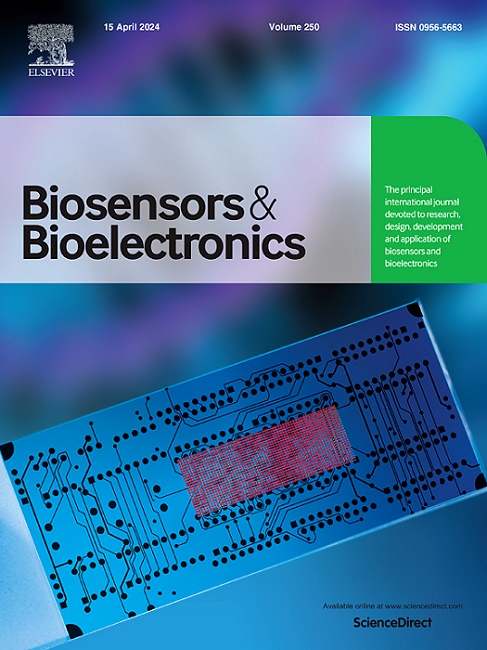机器学习辅助Eu-MOF荧光材料同时监测和去除孔雀石绿
IF 10.5
1区 生物学
Q1 BIOPHYSICS
引用次数: 0
摘要
许多国家禁止在水产养殖中使用孔雀石绿(MG),因为它具有高致癌性、致畸性和高残留倾向。因此,开发能够同时监测和去除MG的材料至关重要。本研究构建了一种稳定的荧光材料(EuUQCA)作为同时监测和去除水中MG的双功能平台。EuUQCA通过荧光猝灭响应实现了MG的超高灵敏度检测,检测限低至16.8 nM。MG的引入使荧光颜色发生了明显的变化,基于EuUQCA的纸张传感器利用这种颜色变化实现了对MG的便携式、目视检测。利用集成智能手机分析RGB值,建立了一种快速、便携的水生环境MG半定量检测方法。在此基础上,建立了基于纸质传感器图像指纹提取和机器学习算法的在线数据分析模型;对模型进行了严格的交叉验证,以提高MG目测的精密度和准确度。此外,EuUQCA粉体对MG具有良好的吸附能力。动力学研究表明,吸附符合准二阶模型,而平衡数据最好用Freundlich等温线描述。这项工作介绍了一种双功能材料,它将MG的同时检测和吸附与机器学习辅助便携式传感器集成在一起;该系统不仅可以提高检测性能,还可以促进分析技术的智能化发展,在环境监测和食品安全领域具有广阔的应用前景。本文章由计算机程序翻译,如有差异,请以英文原文为准。

Machine learning-assisted Eu-MOF fluorescent material for simultaneous monitoring and removal of malachite green
Many countries prohibit the use of malachite green (MG) in aquaculture, owing to its high carcinogenicity, teratogenicity, and high tendency to leave residues. Therefore, it is crucial to develop materials that can simultaneously monitor and remove MG. In this study, a stable fluorescent material (EuUQCA) was constructed as a dual-functional platform for the simultaneous monitoring and removal of MG from water. EuUQCA enabled ultrahigh-sensitivity detection of MG (with a detection limit as low as 16.8 nM) through fluorescence quenching response. The introduction of MG caused a distinct change in fluorescence color, and a paper sensor based on EuUQCA utilized the color change to enable portable and visual detection of MG. A fast and portable semiquantitative method for sensing MG in aquatic environments was established by analyzing RGB values using an integrated smartphone. Moreover, an online data analysis model was developed based on fingerprint extraction from paper sensor images and machine learning algorithms; the model was rigorously cross-validated to enhance the precision and accuracy of the visual determination of MG. Additionally, EuUQCA powder exhibited excellent adsorption capacity for MG. Kinetic studies indicated that adsorption followed a pseudo-second-order model, whereas the equilibrium data were best described by the Freundlich isotherm. This work introduces a dual-functional material that integrates simultaneous detection and adsorption of MG with machine learning-assisted portable sensors; this system can not only improve the detection performance, but also promote the intelligent development of analytic technologies, with broad application prospects in the environmental monitoring and food safety fields.
求助全文
通过发布文献求助,成功后即可免费获取论文全文。
去求助
来源期刊

Biosensors and Bioelectronics
工程技术-电化学
CiteScore
20.80
自引率
7.10%
发文量
1006
审稿时长
29 days
期刊介绍:
Biosensors & Bioelectronics, along with its open access companion journal Biosensors & Bioelectronics: X, is the leading international publication in the field of biosensors and bioelectronics. It covers research, design, development, and application of biosensors, which are analytical devices incorporating biological materials with physicochemical transducers. These devices, including sensors, DNA chips, electronic noses, and lab-on-a-chip, produce digital signals proportional to specific analytes. Examples include immunosensors and enzyme-based biosensors, applied in various fields such as medicine, environmental monitoring, and food industry. The journal also focuses on molecular and supramolecular structures for enhancing device performance.
 求助内容:
求助内容: 应助结果提醒方式:
应助结果提醒方式:


